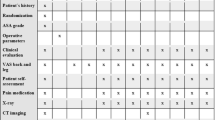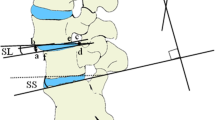Abstract
Intraspinous and pedicle screw-based (PSB) dynamic instrumentation systems have been in use for a decade now. By direct or indirect decompression, these devices theoretically establish less painful segmental motion by diminishing pathologic motion and unloading painful disks. Ideally, dynamics should address instability in the early stages of degenerative spondylolisthesis before excessive translation occurs. Evidence to date indicates that Grade II or larger slips requiring decompression should be fused. In addition, multiple segment listhesis, severe coronal plane deformities, increasing age, and osteoporosis have all been listed as potential contraindications to dynamic stabilization. We reviewed the exclusion and inclusion criteria found in various dynamic stabilization studies and investigational drug exemption (IDE) protocols. We summarize the reported limitations for both pedicle- and intraspinous-based systems. We then conducted a retrospective chart and imaging review of 100 consecutive cases undergoing fusion for degenerative spondylolisthesis. All patients in our cohort had been indicated for and eventually underwent decompression of lumbar stenosis secondary to spondylolisthesis. We estimated how many patients in our population would have been candidates for dynamic stabilization with either interspinous or pedicle-based systems. Using the criteria for instability outlined in the literature, 32 patients demonstrated translation requiring fusion surgery and 24 patients had instability unsuitable for dynamic stabilization. Six patients had two-level slips and were excluded. Two patients had coronal imbalance too great for dynamic systems. Twelve patients were over the age of 80 and 16 demonstrated osteoporosis as diagnosed by bone scan. Finally, we found two of our patients to have vertebral compression fractures adjacent to the site of instrumentation, which is a strict exclusion criteria in all dynamic trials. Thirty-four patients had zero exclusion criteria for intraspinous devices and 23 patients had none for PSB dynamic stabilization. Therefore, we estimate that 34 and 23% of degenerative spondylolisthesis patients indicated for surgery could have been treated with either intraspinous or pedicle-based dynamic devices, respectively.
Similar content being viewed by others
References
Bambakidis NC, Feiz-Erfan I, Klopfenstein JD, Sonntag VK (2005) Indications for surgical fusion of the cervical and lumbar motion segment. Spine 30:S2–S6. doi:10.1097/01.brs.0000174509.31291.26
Boos N, Webb JK (1997) Pedicle screw fixation in spinal disorders: a European view. Eur Spine J 6:2–18. doi:10.1007/BF01676569
Cakir B, Ulmar B, Koepp H, Huch K, Puhl W, Richter M (2003) Posterior dynamic stabilization as an alternative for dorso-ventral fusion in spinal stenosis with degenerative instability. Z Orthop Ihre Grenzgeb 141:418–424. doi:10.1055/s-2003-41568
Christie SD, Song JK, Fessler RG (2005) Dynamic interspinous process technology. Spine 30:S73–S78. doi:10.1097/01.brs.0000174532.58468.6c
Detwiler PW, Marciano FF, Porter RW, Sonntag VK (1997) Lumbar stenosis: indications for fusion with and without instrumentation. Neurosurg Focus 3:e4
Freudiger S, Dubois G, Lorrain M (1999) Dynamic neutralisation of the lumbar spine confirmed on a new lumbar spine simulator in vitro. Arch Orthop Trauma Surg 119:127–132. doi:10.1007/s004020050375
Grob D, Benini A, Junge A, Mannion AF (2005) Clinical experience with the dynesys semirigid fixation system for the lumbar spine: surgical and patient-oriented outcome in 50 cases after an average of 2 years. Spine 30:324–331. doi:10.1097/01.brs.0000152584.46266.25
Iguchi T, Kanemura A, Kasahara K, Kurihara A, Doita M, Yoshiya S (2003) Age distribution of three radiologic factors for lumbar instability: probable aging process of the instability with disc degeneration. Spine 28:2628–2633. doi:10.1097/01.BRS.0000097162.80495.66
Kirkaldy-Willis WH, Farfan HF (1982) Instability of the lumbar spine. Clin Orthop Relat Res 165:110–123
Lazennec JY, Ramare S, Arafati N et al (2000) Sagittal alignment in lumbosacral fusion: relations between radiological parameters and pain. Eur Spine J 9:47–55. doi:10.1007/s005860050008
Mardjetko SM, Connolly PJ, Shott S (1994) Degenerative lumbar spondylolisthesis. A meta-analysis of literature 1970–1993. Spine 19:2256S–2265S. doi:10.1097/00007632-199410151-00002
McAfee PC (1999) Interbody fusion cages in reconstructive operations on the spine. J Bone Joint Surg Am 81:859–880
McNally DS, Shackleford IM, Goodship AE, Mulholland RC (1996) In vivo stress measurement can predict pain on discography. Spine 21:2580–2587. doi:10.1097/00007632-199611150-00007
Mochida J, Suzuki K, Chiba M (1999) How to stabilize a single level lesion of degenerative lumbar spondylolisthesis. Clin Orthop Relat Res 368:126–134
Nockels RP (2005) Dynamic stabilization in the surgical management of painful lumbar spinal disorders. Spine 30:S68–S72. doi:10.1097/01.brs.0000174531.19982.99
Okuda S, Iwasaki M, Miyauchi A, Aono H, Morita M, Yamamoto T (2004) Risk factors for adjacent segment degeneration after PLIF. Spine 29:1535–1540. doi:10.1097/01.BRS.0000131417.93637.9D
Polikeit A, Ferguson SJ, Nolte LP, Orr TE (2003) Factors influencing stresses in the lumbar spine after the insertion of intervertebral cages: finite element analysis. Eur Spine J 12:413–420. doi:10.1007/s00586-002-0505-8
Putzier M, Schneider SV, Funk J, Perka C (2004) Application of a dynamic pedicle screw system (DYNESYS) for lumbar segmental degenerations—comparison of clinical and radiological results for different indications. Z Orthop Ihre Grenzgeb 142:166–173
Rousseau MA, Lazennec JY, Bass EC, Saillant G (2005) Predictors of outcomes after posterior decompression and fusion in degenerative spondylolisthesis. Eur Spine J 14:55–60
Schwarzenbach O, Berlemann U, Stoll TM, Dubois G (2005) Posterior dynamic stabilization systems: DYNESYS. Orthop Clin North Am 36:363–372
Senegas J (2002) Mechanical supplementation by non-rigid fixation in degenerative intervertebral lumbar segments: the Wallis system. Eur Spine J 11 Suppl 2:S164–S169
Sengupta DK (2004) Dynamic stabilization devices in the treatment of low back pain. Orthop Clin North Am 35:43–56
Sengupta DK, Herkowitz HN (2005) Degenerative spondylolisthesis: review of current trends and controversies. Spine 30:S71–S81
Stoll TM, Dubois G, Schwarzenbach O (2002) The dynamic neutralization system for the spine: a multi-center study of a novel non-fusion system. Eur Spine J 11 Suppl 2:S170–S178
Turner JA, Ersek M, Herron L et al (1992) Patient outcomes after lumbar spinal fusions. JAMA 268:907–911
Wiltse LL, Jackson DW (1976) Treatment of spondylolisthesis and spondylolysis in children. Clin Orthop Relat Res 117:92–100
Zucherman JF, Hsu KY, Hartjen CA et al (2004) A prospective randomized multi-center study for the treatment of lumbar spinal stenosis with the X STOP interspinous implant: 1-year results. Eur Spine J 13:22–31
Author information
Authors and Affiliations
Corresponding author
Rights and permissions
About this article
Cite this article
Lawhorne, T.W., Girardi, F.P., Mina, C.A. et al. Treatment of degenerative spondylolisthesis: potential impact of dynamic stabilization based on imaging analysis. Eur Spine J 18, 815–822 (2009). https://doi.org/10.1007/s00586-009-0941-9
Received:
Revised:
Accepted:
Published:
Issue Date:
DOI: https://doi.org/10.1007/s00586-009-0941-9




